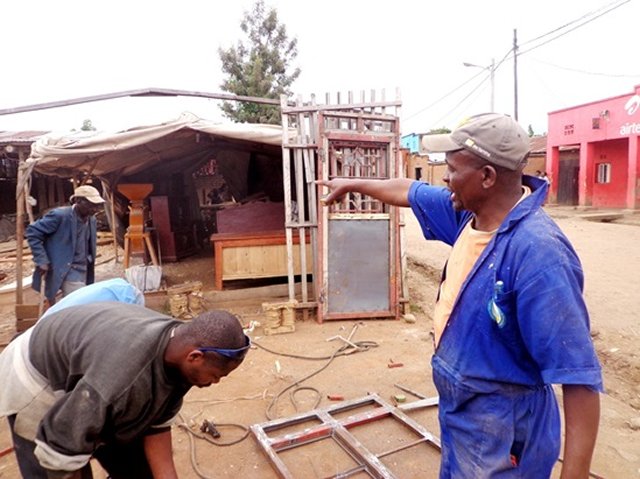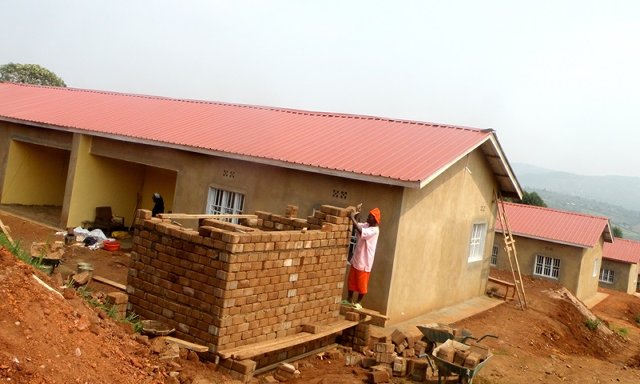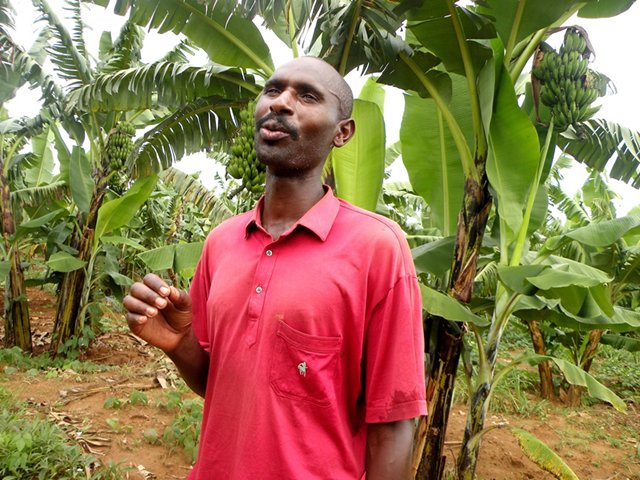
Emmanuel Gakwisi, an ex combatant from Bugesera, Eastern Rwanda used a few capital from government to invest in agri business
Ezra Byiringiro 58, a former Rwandan rebel who surrendered and repatriated back home, has since turned around his life, spending $1 beyond average daily expenditure of a Rwandan household.
In his Musanze town, north of Rwanda, the former combatant operating from Democratic Republic of Congo (DRC) runs a workshop that fabricates metallic doors, house furniture and food industry machinery.
Since 2003, the workshop is his full address, because, “this is the place where I win bread for my family,” says a proud father of four.
Byiringiro, was in 1998 recruited by Democratic Front for Liberation of Rwanda (FDRL), operating from the jungles of DRC.
As a genocidal outfit, whose members are responsible for the massacre of more than a million Tutsi in 1994, FDLR remains one of the most callous groups operating in the Congo.
In 2000, Byiringiro surrendered amongst hundreds of other militias after their ambush plan through the volcano national park flopped.
Like Byiringiro, many of the 13,000 militiamen repatriated since 1997 went through Mutobo camp for a-3 month training. They acquire essential life skills like modern farming, carpentry and masonry and civic education.
“Kill Tutsis everywhere”
According to the U.S. National Counterterrorism Center, the FDLR is responsible dozens of terrorist attacks. These acts of terrorism have killed hundreds of civilians in Rwanda and Eastern DRC. Washington, the European Union and United Nations have booked the group a terror entity, rendering it subject to international sanctions.
Despite the anti-Tutsi propaganda, the low levels rank-and-file who have earned nothing from years of abuse choose to escape.
Ten of the highest ranking commanders are wanted for war crimes including; Victor Byiringiro, Sylvestre Mudacumura, Leodomir Mugaragu, Leopold Mujyambere, Felicien Nsanzubukire, Pacifique Ntawunguka and Stanislas Nzeyimana
These leaders have maintained grip of the genocide ideology imparted in the mass. A commander told The Guardian reporter in 2008: “We have to kill [Tutsis] wherever they are.”
“They gave me a gun and said we were going to fight the Tutsis,” said a teenage-looking combatant. A commander called Rwanda a “Hutu country” which must be brought back to them. “It’s not hard to kill,” said another commander. “You shoot.”
The custodians of this hate ideology are moving freely in European and American cities. German, perhaps from its holocaust history, is currently prosecuting FDLR president Ignace Murwanashyaka and his deputy Straton Musoni.
The two managed the genocide agenda from their homes, going as far using German taxpayer-paid phones.
Calixte Mbarushimana, the Executive Secretary of the rebel group, is a free man in France, which even secured his release from the International Criminal Court in The Hague.
FDLR ideologue Dr. Félicien Kanyamibwa, lives in the State of New Jersey and working with a pharmaceutical company, Hoffman-La-Roche based in Nutley.
His counterpart Dr. Jean Marie Vianney Higiro is a professor in the Department of Communications in Western New England College in Springfield, Massachusetts. They lead an affiliate of the genocide militia.
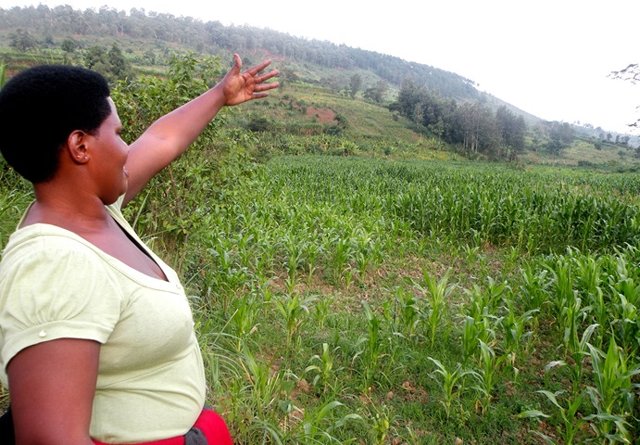
Retired sergent Odette Nyinawumuntu shows the maize farm of her cooperative in Ngoma, Eastern Province.
Nordists or Sudists
According to correspondence within the UN Security Council, Dr. Félicien Kanyamibwa is Number 7 on a list of 12 individuals described as the FDLR “hardliners”.
All men, the political guardians of the group are common faces. EU governments know them, but choose to look away.
Christopher Hakizabera lives quietly in Brussels and so does Alexis Nshimiyimana in Vienna.
A classified report sent by the UN mission in DRC goes more underground with how the FDLR operate and who is in control. They all share the common goal of exterminating Tutsis, but then internal battles of how to achieve that remain ever alive.
Among combatants sent to UN demobilized camps in PR stunts, at least 70% are branded as “Sudists” by their commanders who do not consider them loyal to the FDLR cause, according to the research by United Nations Joint Mission Analysis Centre (JMAC).
“…regional tensions exist within the FDLR between the “Sudists”, that is those from the south, and the “Nordists”, that is those from the north of Rwanda,” says the confidential research document obtained by KT Press.
Northerners are considered as from Gisenyi, Ruhengeri, Byumba, Kigali and the northern part of Kigali Rural. Gisenyi, in the northwest, was considered the core of the northern bloc because former Rwanda leader President Juvenal Habyarimana was from there.
The little-known leader of FDLR Col. Aloys Ntiwiragaba, alias Omar, lives under government protection in Sudan. He was senior aide to Habyarimana, doing all his dirty work.
FDLR reclusive supreme commander, Gen. Sylvestre Mudacumura is also from Gisenyi. A separate 2007 UN study on the same issue says southerners are considered from Kibuye, Cyangugu, Gikongoro, Gitarama, Butare, Kibungo and southern part of Kigali Rurale; the core area being Gitarama and Butare.
When the FDLR ignored an international deadline to disarm, Rwanda was understandably furious. “I have credible information that over 10 top MONUSCO leaders asked to go on leave towards today’s deadline,” said Jean Sayinzoga, Chair of the World Bank-funded Rwanda Demobilization and Reintegration Commission, on January 2.
Indeed KT Press independently established that all top MONUSCO officials, including the UN special representative, Martin Kobler, indeed went on leave. Kobler left office a month earlier and was not expected to return until late January, after the disarmament deadline.
“What else do you think was the motive of these leaders to request for immediate holiday?” Sayinzoga said.
Meanwhile, back home, combatants that gave up their guns, have a new life.
The World Bank supports
Jean Marie Vianney Habumuremyi 40, escaped from the FDLR in 2001. From Rwf 300,000 ($400) startup fund provided by the government, he is worth more than Rwf150m some ten years later.
“I wish I can lead a campaign to tell my compatriots to leave the forest. It’s a shame to live upon plundering when your country is full of opportunities,” says Habumuremyi.
The budget that goes to demobilization and reintegration of ex-combatants is largely supported by the World Bank.
The institution has since 2014 contributed $ 2 million to this project. The bank has pledged $ 8 million for 2015-2017 programs.
The money supports small projects of ex-combatants and their education, housing and even medication for social cases.
Meanwhile, an estimated 3,400 militiamen are still languishing in DRC forests.
Reports say the FDLR elements suffer food shortages yet Habumuremyi not only has abundant food, but also, is a processor.
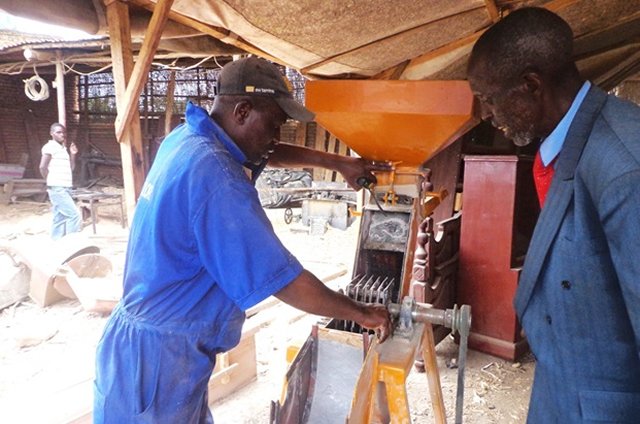
It is worth Rwf 1 million, Ezra Byiringiro told the client who was coming for the mill he fabricated


